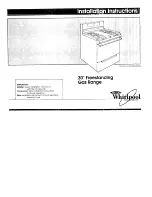
18
Broiling
Broiling uses direct radiant heat to cook food. Changing the
temperature when Custom Broiling allows more precise control
when cooking. The lower the temperature, the slower the
cooking. Thicker cuts and unevenly shaped pieces of meat, fish
and poultry may cook better at lower broiling temperatures.
■
For best results, use a broiler pan and grid (provided on some
models). It is designed to drain juices and help avoid spatter
and smoke.
If you would like to purchase a broiler pan, one may be
ordered. See “Assistance or Service” section to order. Ask for
Part Number 4396923.
■
For proper draining, do not cover the grid with foil. The
bottom of the pan may be lined with aluminum foil for easier
cleaning.
■
Trim excess fat to reduce spattering. Slit the remaining fat on
the edges to avoid curling.
■
Pull out oven rack to stop position before turning or removing
food. Use tongs to turn food to avoid the loss of juices. Very
thin cuts of fish, poultry or meat may not need to be turned.
■
After broiling, remove the pan from the oven when removing
the food. Drippings will bake on the pan if left in the heated
oven, making cleaning more difficult.
Before broiling, position rack according to the Broiling Chart. It is
not necessary to preheat the oven before putting food in unless
recommended in the recipe. Position food on grid in the broiler
pan, then place it in the center of the oven rack. Close the door to
the broil stop position to ensure proper broiling temperature.
To Broil:
1.
Open door to broil stop position.
2.
Press BROIL.
3.
Press START.
4.
Press OFF/CANCEL when finished.
BROILING CHART
For best results, place food 3" (7 cm) or more from the broil
element. Times are guidelines only and may need to be adjusted
for individual tastes. Recommended rack positions are numbered
from the bottom (1) to the top (5). For diagram, see the
“Positioning Racks and Bakeware” section.
*Place up to 9 patties, equally spaced, on broiler pan grid.
Convection Cooking
(Styles 1 & 3 - Electronic Oven Control)
During convection cooking, the fan provides increased hot air
circulation continuously and more consistently throughout the
oven. The movement of heated air around the food helps to
speed up cooking by penetrating the cooler outer surfaces. Food
cooks more evenly, browning and crisping outer surfaces while
sealing moisture inside.
Many foods can be cooked by lowering cooking temperatures
25°F (10°C) and/or cooking time can be shortened by as much as
30 percent. By using multiple racks, you can cook more food at
the same time.
■
It is important not to cover foods so that surface areas remain
exposed to the circulating air, allowing browning and crisping.
FOOD
RACK
POSITION
COOK
TIME
minutes
Side 1 Side 2
Steak
1" (2.5 cm) thick
medium rare
medium
well-done
4
4
4
14-15
15-16
18-19
7-8
8-9
9-10
Ground meat patties*
³₄
" (2 cm) thick
well-done
4
13-14
7-8
Pork chops
1" (2.5 cm) thick
4
20-22
10-11
Ham slice, precooked
¹₂
" (1.25 cm) thick
4
8-10
4-5
Frankfurters
4
5-7
3-4
Lamb chops
1" (2.5 cm) thick
4
14-17
8-9
Chicken
bone-in pieces
boneless breasts
3
4
17-20
11-16
17-20
11-16
Fish Fillets
¹₄
-
¹₂
"
(0.6-1.25 cm) thick
Fish Steaks
³₄
-1"
(2-2.5 cm) thick
4
4
8-10
16-18
4-5
8-9
















































